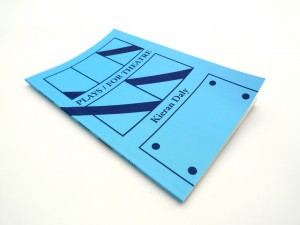 Plays/For Theatre
Plays/For Theatre
by Kieran Daly
bas – books, 2011
44 pages / $10 Buy from bas – books
The genius of the plays in Plays/For Theatre is that they offer almost nothing of anything you’d expect from any kind of play. There are some precedents here in Stein and Beckett in their starkness and refusal, but Daly’s plays inhabit a kind of literalism that avoids both the wordplay of Stein and the ghostly psychodrama of Beckett’s shorter works, even Breath, in which the lights rise to the sound of an inhalation and lower to the sound of an exhalation.
Daly’s work is even more spare than that, usually absent of any kind of staging or even characters unless generic actors are referred to peripherally. What you get instead with Daly’s work is him stretching the form of the play so hard over content completely unsuited to drama that it eventually becomes tough to even read the plays as plays. They’re more like the cadavers of plays, taken out of cold storage for study by students not of the theatre but of a kind of literalism that would make even nouvelle roman writers blush.
Take, for example, the play Gender Trouble by Judith Butler: a Play in its entirety, lack of italics (sic):
ACT.
[Entire text of Gender Trouble by Judith Butler.]
SCENE.
Gender Trouble.
SCENE.
Gender Trouble by Judith Butler. Published 1990.
ACT.
The book Gender Trouble by Judith Butler.
And that’s all you get. The book is dramatized, but not by being reworked through character and setting, but simply by being placed as an object within the form of a play. Most of the plays in Plays/for Theatre behave this way; there are plays about corners, windows, A Thousand Plateaus, numbers, and Law and Order: Special Victims Unit (Season Five) among other things. And while Daly works subtle variations into his presentations, the forthright literalism remains intact. The play about a window is literally that and nothing else.
This, I’m suggesting to you, is what makes the book so great. In combining the quotidian with the empty form of dramatic writing, what you have is something that pulls hard away from both and lets you question just what exactly is a play and what exactly are the things and products Daly presents. Consider this excerpt from Law and Order: Special Victims Unit (Season Five): a Play:
ACT I.
Every episode from Season Five of Law and Order: Special Victims Unit.
SCENE I.
Tragedy.
SCENE II.
Manic.
SCENE III.
Mother.
SCENE IV.
Loss.
The play goes on like that for three pages, and its relative scarcity of content allows you space to consider just what kind of theatre you’re looking at when you happen to be watching Law and Order as well as just what you’re really getting when you see or read a play. By refusing to budge, Daly asks big questions about the nature of drama: what can or can’t be dramatized? Who is responsible in a theatrical production for providing the content? What does the form of drama mean and how does it shape meaning? What exactly is drama, anyway? And so on. And when you read Gender Trouble or watch Law and Order, what kind of dramatization are you getting that’s embedded in the object/product/content?
This is a lot of questions for a slim book of brief spare plays to raise, but Daly does it with a minimum of means, more to his credit for performing a kind of autopsy on the spectacle of traditional drama. And there’s one exception in Daly’s collection that proves the rule that these plays raise many questions. Early on in the text, Testing Water: a Play contains 4.5 solid pages of text of casual instructions on how “you” can perform maintenance on your plumbing if you hear any odd noises when you run the tap. But the torrent of instructions is explicitly labeled “A performance which is not a play. The plumber is not play-ing.” which divides play from performance and serves both as a point of entry to the play-ing of the later texts as well as demonstrates how play-ing, unlike performance, doesn’t contain the essential ingredient of activity that transforms text into performance. If Testing Water is a kind of litany of banal performance instructions for a plumber, it serves as a counterpoint to the vacuum-sealed plays that surround it and raises the question: what is the difference between performance and play-ing?
Daly never explicitly answers this question in his other, more spare texts, but the inclusion of Testing Water allows you to both view the play-ing devoid of performance that might be suggested by the subject matter as well as imagine what activities might take place that transform play-ing into performance, that give a Beckett-esque breath to otherwise inert materials. How, for example, do you perform a windowsill? This may seem like a dumb question but dig a little deeper and what you get is something better: how do you live and work with and act because of the “dead” objects and texts that surround you? How do you play or perform Walden when you read it, or a window when you open it? What part of your daily life constitutes performance, something scripted even if only perfunctorily rather than spontaneous?
The fact that Daly can do so much with so little makes Plays/For Theatre an astonishing book, one not worth just breezing through but really taking your time with, performing the reading, thinking through play and the “play” and how you, as reader and in your own life, are caught up in a richness of performance captured by the minimalism of Daly’s plays.
***
Nicholas Grider is the author of the forthcoming short story collection Misadventure (A Strange Object, 2014).
Tags: Kieran Daly, nicholas grider, Plays/For Theatre

I am all about this. Bought. Very much like your questions in the second to last para too. Great review, and look forward to reading.